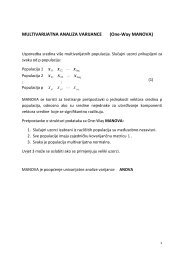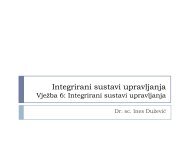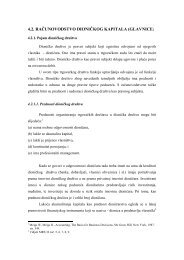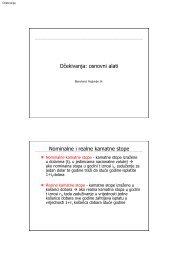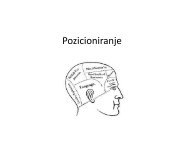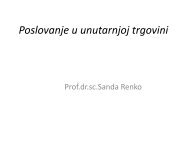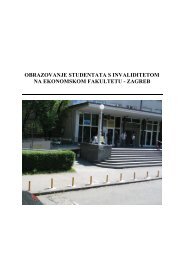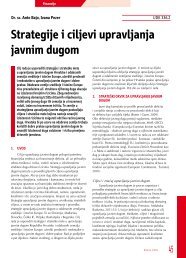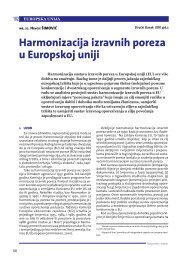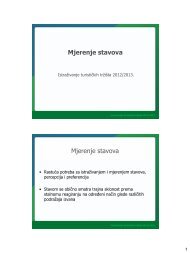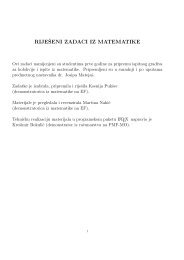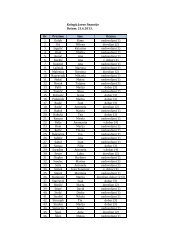WELCOME BROCHURE
WELCOME BROCHURE
WELCOME BROCHURE
- No tags were found...
You also want an ePaper? Increase the reach of your titles
YUMPU automatically turns print PDFs into web optimized ePapers that Google loves.
<strong>WELCOME</strong><strong>BROCHURE</strong>
<strong>WELCOME</strong>!Congratulations on your decision topursue your education with us atUniversity of Zagreb ≤ Faculty ofEconomics and Business.In your preparation for your studies at FEB Zagreb, I encourage you to thoroughly readthis Welcome Brochure and the accompanying Program Brochure.Most importantly, the Welcome and Program Brochure contain information that youneed to know before you leave home. It will provide you with practical information onhow to start planning for this new stage in your life as a FEB student and also outlineenrolment and timetable information. I trust that your experiences at FEB Zagreb will berewarding and inspiring. On behalf of the FEB and University of Zagreb, I welcome you toour community and look forward to seeing you at Orientation meeting.Have a safe trip,Mario Spremić, PhDBDIB Program Director
THISBOOKLETThe information contained in this brochure has been designed specifically to be usefulfor your pre-departure arrangements and your arrival and stay at the FEB and Zagreb.You are encouraged to read it thoroughly, and bring it with you to FEB.For ease of use it has been divided into 4 sections:1. Before you arrive2. When you arrive3. Check-lists4. Contact listThe first section is aimed to introduce Croatia, Zagreb and FEB, but also to guide youthrough all the things you need to do before coming to Croatia. The second section givesyou an overview of all the things you should do upon your arrival, but also provides alist of activities you can pursue once you get settled. Since planning to study abroad cansometimes be stressful, make sure you consult the check-lists in section 3 to make sureyou didn’t forget anything in the process. If you cannot find the answers to your questionsin this guide or your Program Brochure, there is a contact list for the relevant officesto help you find the staff members that can best assist you in answering your questions.Best wishes, safe travels and we look forward to welcoming you to FEB Zagreb in person!FEB International Relations Office Team
CONTENTS1. BEFORE YOU ARRIVE1.1. 1 ABOUT CROATIA 61.1.1. . . Entry to Croatia 61.1.2. .2. Health insurance 61.1.3. Geography 71.1.4. Climate 71.1.5. Culture ure 71.1.6. Communication ion 81.1.7. Money 91.1.8. Holidays in Croatia a 91.1.9. Croatian language 101.2. ABOUT ZAGREB 111.3. ARRIVING TO ZAGREB AND FEB 121.3.1. Arriving riving to Zagreb 121.3.2. Arriving riving to FEB 121.4.ABOUT UNIVERSITY OFZAGREB & FEB ZAGREB 141.5. ACCOMODATION 161.5.1. Residence halls 161.5.2. Private accommodation odation 161.5.3. Student hostels 162. WHEN YOU ARRIVE2.1. STUDYING AT FEBZAGREB 182.1.1. Adapting to a new environment nment 182.1.2. .2. Libraries 182.1.3. Student associations sociations at FEB 202.2. LIVING IN ZAGREB 212.2.1. Where to eat 212.2.2. Sport activities ties222.2.3. Shopping piin Zagreb 232.2.4. Cinemas / Movie theatres 232.2.5. Nightlife ife 232.2.6. Where to go ≤ Zagreb surroundings rounundings 243. CHECK-LISTS3.1. BEFORE YOU ARRIVE RIVE CHECK-LIST 263.2. WHEN YOU ARRIVE RICHECK-LIST 263.3. WHEN YOU LEAVE E CHECK-LIST 264. CONTACTCT LIST4.1. FEB CONTACTS CTS 284.2. OTHER CONTACTS CTS 28
1BEFOREYOUARRIVE
DENTAL MEDICINEBožić AlexandraADDRESS: Martićeva 63 aPhone 01 4604 121WORKING HOURSeven dates ≤ morning: 7am≤1.30pm ;uneven dates ≤ afternoon: 1≤7.30pmIf it’s a weekend / bank holiday, youshould go to the EMERGENCYMEDICAL ASSISTANCE INSTITUTE located inHeinzlova 88. This hospital receivesaccident victims and patients withsudden, serious illnesses 24-hoursa day.In emergencies for which anambulance is needed dial 112!There are hospitals and clinics locatedin all the larger towns and cities, whilesmaller centers have dispensaries andchemists.1.1.3. GeographyCroatia is located in Central and SoutheasternEurope (aka the western Balkans)between Bosnia and Herzegovina andSlovenia. It stretches in the form of anarc from the Danube in the northeast toIstria in the west and Boka Kotorska inthe southeast. It borders the Adriatic Seaalong its 5,835 km coastline. Its area is56,414 sq. km and the area of the coastalsea about 31.900 sq. km. Its size is comparableto that of West Virginia or NovaScotia. Croatia has a 932 km border withBosnia and Herzegovina, a 670 km borderwith Slovenia, a 329 km border withHungary, a 241 km border with Serbia(its Autonomous Province of Vojvodinaentirely) and a 25 km border with Montenegro.Islandsand coastal areas in Croatiahave a Mediterranean climate while inlandareas have temperate continental climatewith hot summers with low overall humiditylevels but frequent rain showers andcold snowy winters. The local terrain isquite diverse given the size of the country.There are flat plains along the Hungarianborder, low mountains and highlands nearthe Adriatic coastline and islands. Croatia’sstrategic location gives it control overmost land routes from Western Europeto the Aegean Sea and the Turkish Straits.The country’s natural resources includepetroleum, some coal, bauxite, low-gradeiron ore, calcium, natural asphalt, silica,mica, clays, salt and hydropower.Croatia can be divided into three majornatural parts: The Pannonian and Peri-Pannonianarea comprises lowland and hillyparts of eastern and northwestern Croatia.The Adriatic Area includes the narrowcoastal belt separated from the hinterlandby high mountains. This is predominantly aKarst area with very dry summers.The Croatian Adriatic coast is one of themost indented in the world: It has 1,246islands and islets with a total coastline of4,058 km, the total length of the mainlandcoast being 1,777 km.1.1.4. ClimateThe climate in Croatia varies from Mediterraneanalong the Adriatic coast to a countryclimate in the inland country. Windensures a cooling breeze in the summerat the coast. The temperature fluctuatesbetween 10 (winter) and the 30 (summer)degrees Celsius. The inland country hasa climate with dry and hot summers andcold, wet winters. The temperature fluctuatesin January around the freezing-point,whereas it can become in August average24 degrees Celsius. In the mountains thetemperature remains in January under thefreezing-point, on average the temperaturefluctuates between -5 and 0 degreesCelsius. Summer is pleasant fresh, in thewinter months it can snow considerably.During August the temperature increasesin the higher areas up to approximately 18degrees Celsius. There is a lot of sunshinein Croatia. The average sunshine is 2,500hours per year.1.1.5. CultureCulture is everything. Culture is the waywe dress, the way we carry our heads, theway we walk, the way we tie our ties. Itis not only “the fact of writing books orbuilding houses” said a famous authoronce. In this page, you will get a sneakpreview into Croatia’s rich cultural heritageand aspects of life.BEFORE YOU ARRIVE 7
MusicCroatian folk music is a mishmash ofdifferent styles, each distinct in its ownway. Violinists or tambura players and aCroatian mandolin accompany Kolo, alively Slavic dance. Dalmatia’s gentle guitarand accordion bands have a distinctlyItalian flavour.smaller finds are exhibited at the archaeologicalmuseum in Split.Architecturally attractive are towns ofDubrovnik, Korčula, Trogir, Šibenik andZadar. Trogir’s medieval core, surroundedby walls, comprises a preserved castleand tower and a series of dwellings andpalaces from the Romanesque, Gothic,Renaissance and Baroque periods. Trogir’schurch of St. Lawrence is the most significantwork of the Romanesque-Gothicstyle in the country.In Istria, the Euphrasian Basilica of Poreč,commissioned by Bishop Euphrasius in535 BC to 50 BC. Basilica contains someparticularly beautiful Byzantine wallmosaics. The architecture of the Croatiancoastal towns is a mixture of Roman, Renaissanceand Baroque.The best preserved among fortified medievaltowns are Korčula and Dubrovnik.The Islands of Hvar and Korčula were bothVenetian naval strongholds. Šibenik iscoastal town with impressive architectureof St. James Cathedral.1.1.6. CommunicationTelephoneCountry code: 385. Telephone booths areoperated by phone cards available at postoffices, news stands and in some touristshops.Mobile TelephoneRoaming agreements exist with most internationalmobile phone companies. Coverageis good. Mobile providers in Croatia are:T-MobileVIPnetTele 2Bon BonTomatoReligionMajority of the Croats is Roman Catholic,while Serbs follow the Eastern OrthodoxChurch and they make up 3 % of population.Muslims make up 1.3% of the populationand they follow Islam religion. TheIslamic Community of Croatia is officiallyrecognized by the state. There’s a tinyJewish population in Zagreb.ArchitectureThe country’s best Roman architecturalremains are in Split and Pula. Don’t missDiocletian’s Palace in Split and the amphitheatrein Pula. Other significant Romansites include Zadar and Salona (archaeologicalsite near Solin), while numerousInternetThere are a lot of internet cafés in Zagrebwhere you will find all you need. Some ofthem are:• Art Net Club, Preradovićeva 25• Cyber Cafe Sublink,Teslina 12• Cyber Funk Cafe, Masarykova 26(in the backyard)• Ergonet, Badalićeva 26c• Internet & Call Shop, Skalinska 3• Internet 0−24, Avenija Marina Držića4 (main bus station)• Internet Centar Galleria, Iblerov trg 10• Iskoninternet − KIC, Preradovićeva 5/IVIP, trg P. Preradovića 5• VIPBEFORE YOU ARRIVE 8
PostThe Central Post Office is located inJurišićeva 13, located just east of the Trgbana Jelačića.Zagreb postal code is HR≤10 000.Working hours at the post offices:Post office in Jurišićeva 13Mon≤Fri: 07:00≤21:00;Sat: 07:30≤14:00Post office in Branimirova 4Mon≤Sun: 0:00≤24:00MediaCroatian media operate in a climate ofrelative freedom following the restrictionsof President Tudjman’s era. The constitutionbans censorship and guarantees pressfreedom. Croatian Radio-Television, HRT, isa national state-owned public broadcasterand is financed by a mixture of advertisingand license-fee revenues. The frequenciesof HRT’s third national TV network wereallocated to a private bidder in 2003.Public TV is the main source of newsand information. National commercialnetworks and dozens of private local TVstations compete for viewers.Press• The main daily local newspapers areVečernji List, Jutarnji List and Vjesnik(Zagreb), 24sata (nation-wide), NoviList (Rijeka), Slobodna Dalmacija (Split).• The weekly press includes Globus andNacional.• You can buy English-language newspaperand books in Algoritam shop, Gajeva 1.TV• Croatian TV (HRT) is public and operatesnational networks• RTL Televizija, RTL2, Nova TV andDOMA TV are national, private channelsRadio• Croatian Radio (HRT) is public and operatesthree national networks• Radio 101, Otvoreni Radio and NarodniRadio and many others are commercialstations1.1.7. MoneyCurrencyKuna (HRK; symbol Kn) = 100 Lipa. Notesare in denominations of Kn 1,000, 500,200, 100, 50, 20, 10 and 5. Coins are indenominations of Kn 25, 5, 2 and 1, and50, 20, 10, 5, 2 and 1 lipa.Currency ExchangeForeign currency can be exchanged in banks,by authorized dealers and post offices.Credit/Debit Cards and ATMsAmerican Express, Diners Club, Master-Card and Visa are widely accepted. ATMsare widespread.Traveller’s ChequesTo avoid additional exchange rate charges,travellers are advised to take traveller’scheques in US Dollars, Pounds Sterling orEuros.Exchange Rate IndicatorsThe exchange rate is variable so please seethe link HNB.BanksBanks are generally open to the public between8 am and 6 pm. You may changeforeign currency in kuna at all banks. Inmoney exchange offices, the exchangerate is somewhat more favourable andthe service is generally faster. There aremany such offices in the city and they areusually open between 8 am and 6 pm,but those at the train (Glavni kolodvor)and bus station (Autobusni kolodvor) areopen 24 hours. On Saturdays the banksare open between 8 am and noon. OnSundays and holidays both banks andexchange offices are closed. Currencyexchange is, however, possible at hotels’reception desks.1.1.8. Holidays in CroatiaJanuary 1 ≤ New Year’s DayJanuary 6 ≤ Three Kings DayEaster and the day after ≤ EasterSunday and MondayMay 1 ≤ Labour Day60 days after Easter ≤ Corpus ChristiJune 22 ≤ Anti-Fascist Struggle DayJune 25 ≤ Day of Croatia StatehoodAugust 5 ≤ Victory and HomelandThanksgiving DayAugust 15 ≤ Assumption of MaryOctober 8 ≤ Independence DayNovember 1 ≤ All Saints DayDecember 25 and 26 ≤ Christmas1.1.9. Croatian languageFoto: arhiva TZGZCroatian (hrvatski, Croatian pronunciation:[hr.va.tski]) is a South Slavic languagewhich is used primarily in Croatia, byCroats in Bosnia and Herzegovina, byCroatian minorities in some neighbouringcountries, in the Italian region of Molise,and parts of the Croatian diaspora.BEFORE YOU ARRIVE 9
Standard Croatian is dialectally based onthe Western Štokavian dialect with theIjekavian reflex of the Common Slavic yatvowel. The Croatian linguistic area encompassestwo other major dialects, Čakavianand Kajkavian, which contribute lexicallyto the standard language. It is writtenwith the Croatian alphabet, based on theLatin alphabet. Along with Serbian andBosnian, Croatian belongs to the CentralSouth Slavic diasystem (also referred to as“Serbo-Croatian”).The modern Croatian standard languageis a continuous outgrowth of more thannine hundred years of literature written ina mixture of Croatian Church Slavonic andthe vernacular language. Croatian ChurchSlavonic was abandoned by the mid-15thcentury, and Croatian as embodied in apurely vernacular literature (Croatianliterature) has existed for more than fivecenturies.Croatian, like most other Slavic languageshas a rich system of inflection. Pronouns,nouns, adjectives and some numeralsdecline (change the word ending toreflect case, i.e. grammatical categoryand function), while verbs conjugate forperson and tense. As in all other Slaviclanguages, the basic word order is SVO;however, due to the use of declensionto show sentence structure, word orderis not as important as in languages thattend toward analyticity such as English orChinese.Nouns have three grammatical genders(masculine, feminine and neuter) thatcorrespond to a certain extent with theword ending, so that most nouns endingin -a are feminine, -o and -e neutral andthe rest mostly masculine with a small butimportant class of feminines. Grammaticalgender of a noun affects the morphologyof other parts of speech (adjectives,pronouns and verbs) attached to it.Nouns are declined into 7 cases: Nominative,Genitive, Dative, Accusative, Vocative,Locative and Instrumental.Verbs are divided into two broad classesaccording to their aspect, which can beeither perfective (signifying a completedaction) or imperfective (action is incompleteor repetitive). There are seven tenses,four of which (present, perfect, future Iand II) are used in contemporary standardCroatian, with the other three (aorist, imperfectand plusquamperfect) consideredstylistically marked and archaic.The alphabet consists of 30 letters.Useful phrasesEngleskiGood morning / Good dayGood evening / Good nightHello / ByePlease / Thank you / You’re welcomeMy name is...I’m from... / I come from...Where is...?I’m sorry / Excuse me...What time is it?Good / BadYes / NoWhat tram goes to...?One (1) / two (2) / three (3) / four (4) / five(5) / six (6) / seven (7) / eight (8) / nine (9)/ ten (10) / eleven (11) / twelve (12)I don’t understand / I don’t speakCroatianHow are you?Water / tea / coffee / juiceRed / blue / yellow / black / white / green/ brownI / you / he / she / it / we / you / theyHrvatskiDobro jutro / Dobar danDobro večer / Laku noćBokMolim / Hvala / Nema na čemuMoje ime je... / Ja sam...Ja sam iz... / Dolazim iz...Gdje je...?Oprostite...Koliko je sati?Dobro / LošeDa / NeKoji tramvaj vozi do...?Jedan / dva / tri / četiri / pet / šest /sedam / osam / devet / deset / jedanaest/ dvanaestNe razumijem / Ne pričam hrvatskiKako si?Voda / čaj / kava / sokCrveno / plavo / žuto / crno / bijelo /zeleno / smeđeJa / ti / on / ona / ono / mi / vi / oniBEFORE YOU ARRIVE 10
1.2.ABOUTZAGREBWelcome to Zagreb, the capital city of theRepublic of Croatia. Zagreb is an old CentralEuropean city. For centuries it has been a focalpoint of culture and science, and now ofcommerce and industry as well. It lies on theintersection of important routes betweenthe Adriatic coast and Central Europe.When the Croats achieved their independencein 1991, Zagreb became thecapital ≤ a political and administrativecentre for the Republic of Croatia. Zagrebis also the hub of the business, academic,cultural, artistic and sporting worlds inCroatia. Many famed scientists, artistsand athletes come from the city, or workin it. Zagreb can offer its visitors theBaroque atmosphere of the UpperTown,picturesque open-air markets, diverseshopping facilities, an abundant selectionof crafts and a choice vernacular cuisine.Zagreb is a city of green parks and walks,with many places to visit in the beautifulsurroundings. The city will enter into thethird millennium with a population of onemillion. In spite of the rapid developmentof the economy and transportation, it hasretained its charm, and a relaxed feelingthat makes it a genuinely human city.For more information, click the followinglink: Zagreb-tourist infoZagreb Facts and FiguresFoto: arhiva TZGZLocationTimenorthern Croatia, on the Sava River,170 km from the Adriatic Sea45° 10’ N, 15° 30’ Esituated 122 m above sea levelCentral-european time (GMT+1)continental climateClimate and Weatheraverage summer temperature: 20° Caverage winter temperature: 1° CPopulation 779,145 (2001)Surface area650 sq. km.InstitutionsThe University21 museums14 galleries12 art collections10 theatresFoto: arhiva TZGZBEFORE YOU ARRIVE 11
1.3.ARRIVING TOZAGREBAND FEB1.3.1. Arriving to ZagrebBy airZagreb Airport (www.zagreb-airport.hr) islocated 17 km from the centre of the city,or 20≤25 minutes by bus. Information onflights can be obtained by calling +3851 6265≤222. Once you have reached“Pleso” Zagreb airport, take a CroatianAirlines bus that will drop you off at theCentral Bus Station (Autobusni kolodvor),Marin Držić Avenue (www.plesoprijevoz.hr). From there you can take trams to yourdestination. A one-way airport bus ticketcosts 30,00kn and departs daily everyhalf-hour, the first one leaving at 05:00,the last at 20:00 hours. You can also takea taxi in front of the international arrivals,but the bus is much cheaper.By trainZagreb is also linked into the Europeanrailway system and lies at the crossroadsof major routes (Croatian Railways ≤www.hznet.hr). The Main Railway Stationis located in the centre of the City (at KraljTomislav Square 12, a ten minutes walkfrom the central city square). Trams No. 6or 13 will take you to the main city square.Information on arrivals and departurescan also be obtained at the travel agency“Croatia Express”, tel: +385 1 4573 253.By bus or by carMain international routes / highways are:Trieste ≤ Ljubljana ≤ ZagrebGraz ≤ Maribor ≤ Zagreb (A2)Klagenfurt ≤ Ljubljana ≤ Zagreb (A3)Budapest ≤ Varaždin ≤ Zagreb (A4)The Central Bus Station is located onMarin Držić Avenue, a few minutes bytram (line number 6) from the central citysquare. Information can be obtained onweb page www.akz.hr or traffic officetelephone number: +385 1 6008-645.1.3.2. Arriving to FEBOnce in Zagreb, you can reach the Facultyof Economics and Business by publictrams. Tram lines: from Ban J. Jelačićsquare (center of the town): trams number1 or 17 ≤ get off at the Svetice stop (8stops from the Main Square ≤ the Ban J.Zagreb - broad centerJelačić square); trams 11 or 12 ≤ get offat the Bukovačka stop (7 stops from theMain Square ≤ the Ban J. Jelačić square),in front of the football stadium; from theMain railway station: trams number 4 or9 ≤ get off at the Bukovačka stop (tramnumber 4) or Svetice stop (tram number9); from the Main bus station: tram number7 ≤ get off at the Bukovačka stop (7stops from the main bus station Zagreb).Public transportPublic transport in Zagreb consists of trams,buses, funicular and train. It is operated bya company Zagrebački električni tramvaj(ZET) in cooperation with Croatian Railways.How do you get your monthly/year pass for public transportin Zagreb?On one of the ZET’S main stations get aform for getting a pass (for example, inHeinzelova street, where trams turns, atStockholmMoscowGoteborgCopenhagenAmsterdamBerlinLondonBruxellesPragueParisMunichZurichViennaBudapestZAGREBSarajevoLisbonMadrid BarcelonaRomaSkopjeIstanbulBEFORE YOU ARRIVE 12
MREŽA DNEVNIHTRAMVAJSKIH LINIJAREGULAR TRAM SERVICESSveti DuhSlavenskogaM. RadevMandaličinaSelskaMANDALIČINASlovenskaNehajskaTrešnjevački trgJadranska avenijaMIHALJEVACGračanske stubeGrač. MihaljevacGračani15815 DOLJE14 JandrićevaRadićevo šetališteJANDRIĆEVAGupčeva zvijezdaBelostenčevaBRITANSKI TRGGrškovićevaBadalićevaTehničkim.PetrovaradinskaRudeškaJarunStaglišćeSrednjaciHorvatiKnežijaStud.dom"S.Radić”MEDVEŠČAKUSPINJAČAtrgJ.JELAČIĆABritanskiFrankopanskaSavski gajTrnskoVrbikSveučilišnaalejaMiramarskaLisinski6SOPOTKrugeVelesajamMuzej suvremeneumjetnosti714SredišćeTRGVončininaPetrovaStrojarskaUtrinaŠubićevaDržićevaZAGREBAČKIHOLDING d.o.o.PODRUŽNICAZAGREBAČKI ELEKTRIČNI TRAMVAJOlipska8ZAPRUĐE14MašićevaJordanovacTuškanovaHeinzelovaŠulekovaBukovačkaHondlovaKAPTOLULICAVLAŠKADUBRAVATRG BANA127Draškovićeva5 MAKSIMIR6DUBRAVA611 1214 8 4MAKSIMIRSKA11 ILICAILICA1113HEINZELOVA2 1Trg hrv.MAKSIMIRSKA17ČRNOMEREC12velikanaTržnicaRELJKOVIĆEVA13Kvatrić14ŠUBIĆEVATalovčeva Frankopan.PRAŠKA DRAŠKOVIĆEVA Trg žrtavaKlinikaSVETICEFRANKOPANSKA TRGfašizmaZAPADNIMAŽURANIĆA1za1ULICA 1traumat.KOLODVOR17KRALJATrg m. Tita17ULICA 9ZVONIMIRA9ZrinjevacKNEZA 13JagićevaMISLAVABORONGAJAdžijinaVodnikovaJUKIĆEVASheratonSAVSKAGLAVNI7 5KOLODVORBranimir.Branimir. trž. Trg kralja Petra Krešimira IV136ULICA 64KNEZA 8MIHANOVIĆEVA 2BRANIMIRA 2912 13 17 14 4 912 Branimirova93 OZALJSKA TRATINSKAAUTOBUSNI KOLODVOR2 8 6 7 5LJUBLJANICAStud. centarAVENIJAMARINASAVSKADRŽIĆAULICA5ZagrepčankaGRADA13VUKOVARA3 133 Getaldićeva2ČavićevaUčiteljski fakultet1351714 4ULICAVjesnikSlavonskaŽITNJAKGRADAAVENIJAGOSPIĆAElkaPrisavljeMARINADRŽIĆAMunjaVeslačkaFolnegovićevoZagrebačkinaselje8 6 7transportiBorovje253 SAVIŠĆE174 SAVSKI MOSTMost mladostiHORVAĆANSKAPREČKO7Trg dr. F. TuđmanavrtBotan.VodnikovaAVENIJADUBROVNIKRIBNJAKRAČKOGAKVATERNIKOVKONTAKT CENTARPozivom na broj 060 100 001* dostupne su informacije o: - dolasku tramvaja na konkretno - odabrano stajalište- voznom redu u autobusnom prijevozu- aktualnom stanju u prometu- prometnim područjima i zonama- cijenama prijevozaRadno vrijeme Kontakt centra je radnim danom od 7.30 do 20.00 sati.Sugestije putnika rado ćemo poslušati na besplatnom telefonu 0800 200 060.javnost@zet.hrwww.zet.hrRavniceSveticeHarambašićevaRadničkaHeinzelovaDonje SveticeIvanićgradskaFerenščicaLjubijskaKapucinskaGrižanskaDankovečkaČulinečkaAleja javoraPoljanice IV114DUBECTRAMVAJSKE LINIJETRAM ROUTES1 ZAPADNI KOLODVOR - BORONGAJ2 ČRNOMEREC - SAVIŠĆE3 LJUBLJANICA - SAVIŠĆE4 SAVSKI MOST - DUBEC5 PREČKO - MAKSIMIR6 ČRNOMEREC - SOPOT7 SAVSKI MOST - DUBRAVA8 MIHALJEVAC - ZAPRUĐE9 LJUBLJANICA - BORONGAJ11 ČRNOMEREC - DUBEC12 LJUBLJANICA - DUBRAVA13 ŽITNJAK - KVATERNIKOV TRG14 MIHALJEVAC - ZAPRUĐE15 MIHALJEVAC - DOLJE17 PREČKO - BORONGAJLEGENDA/LEGENDHORVAĆANSKATRAM st. u oba smjeraTRAM stop - both directionsTRAM st. u jednom smjeruTRAM stop - one directionAutobusni terminaliBUS terminalNaziv uliceStreet nameLinije broj 1 i 3 ne prometuju subotom, nedjeljom i blagdanomRoutes 1 and 3 doesn`t operate on Saturday, Sunday or public holidays26.03.2011.Bulić - KolmanBorongaj near FEB, at Remiza Ozaljska 105or in Petrićeva 4 beside the main Ban JosipJelačić square) or you can just come to theInternational Relations Office at the Facultyand we will help you fill out the application.Get a stamp of the Faculty where youstudy on the filled form and one photo(30 x 35 mm)Go with the stamped form and a photo,(your x-card, not all students will get it)and indeks to one of the below mentionedZET’S branch-offices, where they will makeyou your pass. This costs 30,00 HRK.Student’s year passes are made from theend of September to the mid of Novemberin the following ZET’S branch-offices:To see the office hours follow this link: ZETDue to introduction of new system ofticket charging, i.e. paying your tramrides with so called “smart” cards, somechanges regarding the issuing of studentpasses may apply. For more informationplease visit www.zet.hr, or call ZET on+385 1 3651 5551. ZET, Ozaljska 105, east entrance2. BORONGAJ, tram terminal3. ZAPRUÐE, Zlatka Balokovića bbStreet4. DUBRAVA, ZET terminal5. SAVSKI MOST (SavaBridge),Savska bb, tram terminal6. MAŽURANIĆ SQUARE,Mažuranić Square7. ČRNOMEREC, tram terminalFoto: arhiva TZGZBEFORE YOU ARRIVE 13
1.4.ABOUTUNIVERSITY OFZAGREB ANDFEB ZAGREBThe University of Zagreb (1669) is theoldest and biggest university in South-Eastern Europe. Ever since its foundation,the University has been continually growingand developing and now consist of29 faculties, three art academies and theCentre for Croatian Studies. With its comprehensiveprograms and over 50,000full-time undergraduate and postgraduatestudents the University is the strongestteaching institution in Croatia. It offers awide range of academic degree coursesleading to Bachelor’s, Master’s and Doctoraldegrees in the following fields: Arts,Biomedicine, Biotechnology, Engineering,Humanities, Natural and Social Sciences. Itis also a strongly research-oriented institution,contributing with over 50 percent tothe total research output of the country.Faculty of Economics and Business is a partof the University of Zagreb. The Facultystarted out as the School of Commerceand Transport in 1920, whose purpose wasto provide theoretical education in fieldsof banking, domestic and internationaltrade, transport and insurance. Since thenit has often changed its name but never itsmission - to emphasize the importance ofeconomics and business for the well-beingof the country and its citizens, as well as toeducate experts in these fields, especiallyin the current environment of internationalizationand globalization.School of Commerce and Transport becamethe Economic-commercial Schoolwith the legal status of the University’sfaculty in the 1925, and has also performedthe procedure for acquiringthe doctorate in economic-commercialscience. Economic-commercial School becamethe Faculty of Economics in 1947. In1956 the School of Business was founded,with the two-year study program andcurriculum that was adjusted for adultstudents who already had experience inbusiness. In 1968 the two schools weremerged together and the Faculty of EconomicScience was founded. In 1982 theFaculty of Economic Science and the Facultyfor International Trade merged intothe Faculty of Economics and Business.Vision of The Faculty of Economics andBusiness is to develop as a unique and internationallyrecognized institution withinthe University of Zagreb, the leader inthe region, boasting the highest scientificresearch and teaching standards as wellas first class study programs harmonizedwith the world and European standards,and Croatia’s specific features, a gratifiedteaching staff compensated for their endeavors,and the students who will be thepride of the Faculty, University and Croatia.The Faculty of Economics and Business ofthe University of Zagreb was rewarded theprestigious EPAS accreditation for the EBIP/BDIB programme by the European Foundationfor Management Development (EFMD)SOUTHMAIN ENTRANCE − WESTat the meeting of its Accreditation Boardon 9 February 2011. You can find moreinformation about the accreditation atfollowing link: EFMDAfter we gained additional space in 1987,The Faculty of Economics and Business inZagreb became one of the most modernand largest buildings for higher educationin this part of Europe. Polyvalence of usagewith a variety of content makes it possiblefor this Faculty to hold a quality program,host national and international congresses,physical education of students, sportcompetitions, secure adequate nutritionfor students and employees of the Faculty,provide the opportunity to purchase dailynecessities, books, etc.All halls are fully equipped with IT equipment,students have two teleconferencehalls at their disposal, a large number ofair-conditioned lecture halls, a few PC labsand modern lecture hall 3 redecoratedespecially for lectures in larger groups.EAST HALLS WEST HALLS NORTH HALLS SOUTH HALLS15 (ground floor −congress hall)16, 17, 18, 19, 20(2. floor)21, 22, 23, 24, 25, 26(3. floor)29 (library)EAST1, 2, 3, 4, 5, 6(ground floor)7, 8 (1. floor)9 (2. floor)10 (3. floor)11, 12, 13 (2. floor)14 (1. floor - new hall)34 (1. floor)35 (2. floor)36 (3. floor)37 (4. floor)38 (5. floor)NORTH30, 31 (3. floor)32, 33 (4. floor)BEFORE YOU ARRIVE 14
The Grading SystemGrading system is arranged with the Statuteof the University of Zagreb, which isavailable on the University’s web-site www.unizg.hr, and with the Statute of Faculty ofEconomics and Business and Rules of studies,published on www.efzg.hr.Comparison of grading scales(ECTS & UNIZG)ECTSABCD / EFX / FUNIZG5 (excellent)4 (very good)3 (good)2 (sufficient)1 (fail)*ECTSgrading system ranks students accordingto statistical data of success of allstudents during the taking of an exam. Thissystem is in the initial stage.Quick facts about FEBTotal area (m²) 29,470Number of lecture halls 42Total sitting capacity 3,550Largest lecture hall (“Congress hall”)≤ number of seats≤ surface (m²)Number of cabinets for teaching staff 157Centre for Postgraduate Studies≤ number of halls≤ number of seats≤ halls ≤ total surface (m²)≤ Centre ≤ total surface (m²)Hall for the Faculty Council≤ number of seats≤ surface (m²)Library and documentation with reading room and auxiliarystoreroom (and the archive of faculty)585974617028957780911,935 m²Reading room for students (of the total surface) 600 m²Total area for sports facilities (with polyvalent halls for various sports) 4,990 m²The main sports hall (total surface) 1,742 m²The main sports hall≤ wardrobes with sanitary facilities≤ number of seatsAdditional sports facilities -total area(including halls for recreation and gym)Rooms of high category (apartments, single and double rooms)for the accommodation of guests, especially lecturers and researchersPremises for social standards - total catering area(restaurant, self-service, snack)Daily meal production≤ kitchen≤ fast food restaurant61,2201,730 m²71,650 m²3,0002,000BEFORE YOU ARRIVE 15
1.5.ACCOMODATIONThere are two ways to rent a room/flat:1. Send an email/check the offer of thefollowing real estate agencies that areavailable online:Foto: arhiva TZGZ• Adria Sektor, as@adria-sektor.com• Hillberg, info@hillberg.hr• Zagreb West, info@zagrebwest.hr• Optimum nekretnine,optimum@zg.htnet.hr• Rost d.o.o., info@rost.hr1.5.1. Residence hallsThe Ministry of Science, Education andSports allocates a number of rooms toforeign students that come to Zagreb aspart of one of the official exchange programs(CEEPUSor a bilateral agreement ofUniversity of Zagreb and a foreign university)in one of the five student residencehalls in Zagreb. The rest of the foreignstudents have to find their accommodationby themselves. There are five studentdormitories that are open to domesticand international students. The rooms inthe residences are double or triple (thereare no single rooms) and sometimes havetheir own bathrooms. In other cases bathroomswill be shared by the residents ofthe same floor.1.5.2. PrivateaccommodationFor those who are not assigned universityaccommodation, it is necessary to lookfor alternatives such as private rentalaccommodation. Rents vary greatly accordingto location, room size, facilityetc. Overhead expenses are sometimesincluded in the price, and sometimesare paid by the consumer. Payment isusually expected at the beginning of themonth, while some landlords requestpayment for several months in advance.The easiest way to rent a room or a flat isto run an advert in a newspaper or in theclassified ads e.g. „Plavi oglasnik“ (www.oglasnik.hr).2. Look for/run an advert in a newspaper orin the classified ads e.g. “Plavi oglasnik”.Examples of prices:Single room with shared kitchen andtoilet: 100-200 EUR per month;Studio apartment: 300 EUR per month.1.5.3. Student hostelsIf you prefer private accommodation andwould like to live in a rented flat, beforechoosing a nice one, you might want tospend some time in a hostel. Therefore, wesuggest youth hostels.• Residence hall Cvjetno naselje,Odranska 8, Zagreb;phone: +385 1 6191≤245• Residence hall Stjepana Radića,Jarunska 2, Zagreb;phone: +385 1 3634≤255• Residence hall dr. Ante Starčevića,Ljubljanska 2, Zagreb;phone: +385 1 3095≤434• Residence hall Laščina, Laščinska c.32, Zagreb; phone: +385 1 2430≤615Living expensesFoodRoom rental and utilities(water, electricity, heating, phone)TransportationBooksOther/Miscellaneous1.000,00 HRK per month1.500,00 HRK per month100,00 HRK per month400,00 HRK per month800,00 HRK per monthTOTAL 3.800,00 HRK per month (app. 550,00 €)*estimation of University of Zagreb for the year 2011**this is just a rough guide and students may actually spend more or less than these amounts.BEFORE YOU ARRIVE 16
2WHENYOUARRIVEBEFORE YOU ARRIVE 17
2.1.STUDYINGAT FEB ZAGREB2.1.1. Adapting to a newenvironmentStudying and living abroad brings a fullrange of new experiences. The first coupleof weeks might be difficult since everythingwill be more or less new to you.However, the beginning stage is characterizedby excitement, expectation andenthusiasm. To make your adaptation aseasy as possible, every exchange studentwill meet his/her student ≤ mentor (who isa FEB student) from eSTUDENTassociationduring the Welcome Meeting. Studentmentorswill help exchange students geta resident permit at the police station,explain going around Zagreb, help withbuying food on the famous x-card etc.You can also contact a Student InternationalOrganization ≤ ZAGREB EXCHANGECOMMITTEE.ZEC is a group of volunteers who helpInternational Students that come toZagreb to adapt to their new life. Theyorganize different events and activities forexchange students in Zagreb. You canjoin them on facebook.Important telephone numbers112 Emergency Call192 Police193 Fire-service194 Ambulance902InternationalInformation981 General Information11988Telephone numbersof local subscribers987 Road assistance9841 Sport information+385 1 61 01 111MunicipalAuthoritiesFollowing the initial excitement there maycome some annoyance with the universitybureaucracy and the exhaustion of speakingand listening in another languageevery day or you might get homesick atsome point and start feeling some hostilityto the new culture.Please remember you are always welcometo drop into the International Office at FEBif you need to talk about any problemsyou might have. We are here to help youadjust and feel as much at home as possible.Also, below you can find a list of IMPORTANTTELEPHONE NUMBERS:2.1.2. LibrariesLibrary Center at Faculty of Economics &Business, founded in 1921 within at thattime The Higher School of Commerce &Traffic. In 1954 inside the Library Departmentwas founded the DocumentationCentre in order to develop informativefunction trough the content-relatedanalysis of the library material and thetransfer of information. The aim has beenset upon assistance of the teaching activityby conveying information on referencesources related to scientific work of theteachers, candidates for master’s anddoctor’s degree, as well as support tostudents for the broadening knowledgein economics and related disciplines.Since 1991 library operates as The Libraryand Documentation and as of June 01,2006 changed its name to the Library &Documentation Centre.In order to meet the traditional as well asthe modern services of running the library,the LDC during the last ten years enabledits users: to search of the library collectionsthrough the on-line catalogue, viewthe up-dated information on Web-pages,the data-bases in the field of economics,adjusted ordinances on the use of libraryservices, users training for the use ofelectronic data sources, computerizedstudy-room designed for writing of scientificand professional papers, some 40 PCSassigned for the purpose of users etc.WHEN YOU ARRIVE 18
LCD information at FEB ZagrebLibrary’s fund (official report from 2001)2,5 mil volumes on 114 km of shelves(of that: 66 km of books and 48 kmof periodicals)Special collections: collection ofhandwriting and old books, graphiccollection, collection of geographicmaps and atlases, collection of musicsources and audio materialsPlaces in reading rooms 1,100Additional places in reading roomsof special collection rooms64The opening hours for the users are:at FEB ZagrebMonday ≤ Thursday: 08:15-19:45Friday: 08:15-18:45Saturday: 08:15-13:45Departments for study work 10Places in seminar halls 100IT equipment for users112 computers in reading roomswith free access30 laptops16 computers in electronic study room10 PCM/CIA Ethernet network cardsBesides the services to the regular users,the library provides services to the externalusers (visitors) from all over the World,through interlibrary loans or on personalrequests for the use of services within thelibrary premises.National and University Library Zagreb,founded in year 1607, is public institution ofnational significance which conducts libraryand informational function of NationalLibrary of Republic of Croatia and centrallibrary of the University of Zagreb. It collects,builds and organizes Croatian and nationallibrary collection, including electronic literature,as well as acquisition of foreignscientific literature on national and universitylevel, educates, rents computer equipmentand space etc. You can come here to study,research or just borrow books.Working hours:at National and University LibraryZagrebHours for user:Monday 8:00 ≤ Saturday 15:00Central Information Service:Monday ≤ Friday 8:00≤21:00Saturday 8:00≤15:00Registration:Monday ≤ Friday 8:00≤18:00Saturday 8:00≤15:00Lending, Inter-library lending:Monday ≤ Friday 8:00≤18:00Reading-room:Monday ≤ Friday 8:00≤21:0 0Saturday 8:00≤15:00Collections:Monday ≤ Friday 9:00-14:30Scientific information (DIALOG, ISI):Monday ≤ Friday 9:00≤17:00Zagreb City Libraries is a modern and wellorganizednetwork of public libraries. It isthe biggest institution among public librariesin Croatia and function as the centrallibrary for all public and school librariesin the City of Zagreb, Zagreb Countyand Krapina-Zagorje County, and, at thesame time, is one of the greatest culturalinstitutions in the town. The City Libraryof Zagreb and the Božidar Adžija Libraryconstitute, considering their collectionsand scopes as public and scientific libraries,the core of Zagreb City Libraries network.Besides these two main libraries there arealso the County Research and DevelopmentDepartment and 12 branch librarieswith a net of 31 smaller branches on 45locations. There is also Bookmobile Serviceprovided by two bookmobiles that standon seventy four stations. The City Library ofZagreb was founded in 1907 and BožidarAdžija Library in 1927, and they are theoldest public libraries in Zagreb and amongthe first public libraries founded in Croatiawith their long-standing tradition of servingthe local community and offering theaccess to many valuable local, national andinternational sources of information as wellas all sorts of librarian and cultural servicesto wide age groups of citizens.From its beginnings the City Library ofZagreb is distinguished as a “free, publicand modern library, founded and settledfor all citizens of Zagreb” (from the Rulesof Procedure dated 1908). It still operatesaccording to the same theses.WHEN YOU ARRIVE 19
2.1.3. Student associationsat FEBStudent Council (Studentski zbor). StudentCouncil deals with student problems,intermediates between FEB’S Managementand students and realizes its own projects.AIESEC is the biggest world studentorganization, international platform foryoung people to discover and developtheir potentials. Its goals AIESEC achievesthrough development its members,giving them possibilities of participatingin international practice program,educational conferences and taking overleadership positions in the organization.AIESEC is global, apolitical, non-profit andindependent organization led by students.Croatian Academic Community (Hrvatskaakademska zajednica). Numerous studentcommunity which gathers current andgraduated students of Croatian universities,intercedes for improving student standards,protects and promotes student interests,opens possibilities of scholarships…Croatian Student Association (Hrvatskastudentska asocijacija). The main goalof HSA is achievement and protection ofstudent rights, improvement of studentstandards and efficiency of educationalsystem.eSTUDENT ≤ an association founded byFEB students, with the help of teaching assistants,professors and the dean. Visionof the association’s founders, which gathersstudents with highest potentials in thefield of economic sciences, is, throughdevelopment and members’ education,to positively influence on society developmentand economy in the whole.Manager ≤ students magazine ≤ astudents’ business magazine of FEB Zagreb.Rowing club Ekonomist (Veslački klubEkonomist) was founded in 2002 asa continuation of rowing section of FEB,according to the pattern of prestigiousworld universities. Goal of VK Ekonomist isallowing the members to practice rowingbesides their student activities and promotingrowing in academic and businesscommunity.BIT ≤ Association for promoting BusinessInformatics (Udruga za promicanjeposlovne informatike) in January 2005,BIT Association was founded by 4th yearstudents of Business Informatics major,with the goal of promoting, developmentand improvement of informatics in businessand studying.Financial Club (Financijski klub) is a specializedstudent association which givesits members additional financial education.Its main function is provocation offinancial knowledge of its membersand giving platforms and projects for itsimprovement through mutual gatherings,workshops and other numerous interestingcontents. Club functions from 2005 atFEB Zagreb. Working in the club, they tryto connect FEB, students and members ofbusiness community in the field of financeand related themes.Association of tourism students of FEBZagreb (Udruga studenata turizmaEkonomskog fakulteta) is founded in1998 with the goal of interconnection ofall students from “Tourism” and “Touristicbusiness” majors through travelling, presentations,debates and organization ofguest lectures of tourism practice experts.Sport Society of FEB Zagreb (Športskodruštvo Ekonomskog fakulteta) isa sports association. Sportsmen of FEBZagreb are traditionally achieving enviousresults and they defend colors of FEB andUniversity on European and world competitions.Wish for improvement of sportitself at the FEB, stimulating excellenceand participation of greater number ofstudents in sport activities and in competitions,was the motive of FEB’S Managementand Physical Education Departmentto found ŠDEF.Ideo ≤ Association of Marketing majoringstudents at FEB (Ideo ≤ Udrugastudenata smjera Marketing Ekonomskogfakulteta Sveučilišta u Zagrebu) isthe first association founded by studentsmajoring in marketing with the goal ofassurance of identification of marketingprofession and connecting students withother organizations and profession itself.It tends to create a network of marketingexperts of broad knowledge spectrum,which will be recognized in businessworld. Becoming the center of marketingin Europe, which is also a vision of association,suggests high goals which membersof Ideo have set by its foundation.Student´s Association manager of Facultyof Economics & Business, Zagreb≤ was officially registered on the June 18,2009. It was established in the purposeof developing and improving the educationof students and to help introducemembers of the association with the areamanagement.Oikos Zagreb is the first local branch of aninternational student organization OikosInternational and deals with sustainableeconomics and management.Local branch Oikos Zagreb is focusedon sustainable business and economicconnections with areas such as designand architecture, education and culture,politics and journalism, construction andelectrical engineering.WHEN YOU ARRIVE 20
2.2.LIVINGIN ZAGREBFoto: arhiva TZGZ2.2.1. Where to eatStudent restaurants andcafeteriasMeals, cafe, refreshments and cakes ataffordable prices are served in studentrestaurants and cafeterias run by theStudent Centre University of Zagreb.Services and offerings may vary in over 20restaurants at various locations in the city,usually within Faculties of the University.The biggest student restaurant is locatedin the Student Centre Savska 25. You canalso eat in student restaurant at Facultyof Economics & Business. There are twopossibilities:• KEFA ≤ fast food, ice-cream and cakes• RESTAURANT AT FEB ≤ cooked mealRestaurants and cafeteriasin ZagrebZagreb offers hundreds of tastes at thetable... You will find here a rich offeringof places to eat and sometimes gastronomicalsurprises. In the city centre or surroundingexcursion places, with pleasantsounds of the recognizable “tamburica”(a national instrument similar to mandolin)or piano... according to situation andtaste, you can choose an ambient andmenu. One thing will remain the same:recognizable national dishes.Everyone will find his favorite restaurant,to which he will return with pleasure andwhere he will always feel welcomed...TippingIt is customary in Zagreb to give tips inrestaurants and similar services (to tourist,museum and other guides). The tippingranges between 5 and 10 percent ofthe service amount. The prices in storesand shops are fixed and tipping is notcustomary. In the restaurants there aremenus in several languages, and thewaiters (staff) know the basic professionvocabulary in foreign languages, usuallyEnglish and German. A “service charge”is already included in restaurant bills, butit is customary to “round off” a restaurantbill. For special services rendered by hotelpersonnel one usually tips between 20,00HRK and 50,00 HRK.More information about restaurants pleaseclick the following link: RestaurantsFoto: arhiva TZGZCroatian cuisineZagreb cuisine is the combination of richheritage reflecting the troubled history.Citizens of Zagreb were always attentiveto what they ate. In the medievalGradec there were already 90 craftsmenrelated to food. It is worth mentioningthat Zagreb citizens like home-cookeddishes, generating numerous traditionalgastronomy events with presentationsand ratings in the town and its vicinity.Surveys show that citizens of Zagreb aregreat admirers of Mediterranean cuisine,probably due to undoubtedly betterfood selection, than Dalmatians. ModernZagreb cuisine and diet habits of itscitizens are at the Croatian top from thenutritionist’s point of view.Every holiday has its typical dish. Porkand potato stew is eaten on pilgrimagesand at fairs; cod is prepared for ChristmasEve and Good Friday; pork is eatenon New Year‘s Day; doughnuts are aninseparable part of carnival festivities,and in the south they prepare a similarfried sweet dish known as hrostule. Hamand boiled eggs with green vegetablesare served at Easter, while desserts comprisetraditional cakes (e.g. pinca). KulenWHEN YOU ARRIVE 21
ham and cottage cheese with sour cream,fish stew, venison.To read more about Croatian cuisine andtraditional dishes please click on underlinedtext.Foto: arhiva TZGZ(hot-pepper flavored sausage) at harvesttime, goose for St. Martin s Day, turkeyand other fowl, as well as sarma (meatstuffedcabbage leaves), are served onChristmas Day.At weddings, a variety of dishes with dozensof cakes and biscuits are served, includingbreskvice, shortbread bear paws, gingerbreadbiscuits, fritule ≤ plain fritters, etc.The favorite meals of very many peopleon all occasions include spit-roasted lamband suckling pig, grilled fish, calamaricooked in various ways, barbecue dishes≤ ražnjići, ćevapčići and mixed grill ≤ prosciuttoand sheep’s cheese, or smokedCroatian WinesCroatia is justifiably proud of its broadpalette of high quality wines (up to700 wines with protected geographicorigin) and brandies, fruit juices, beersand mineral water. In the south, peopledrink bevanda with their food (heavy,richly flavored red wine mixed with plainwater), and in north-western regions,“gemisht” (dry, flavored wines mixed withmineral water).National drinks• Vino (wine) as a rule of thumb, thebest red wines come from the south,and the best whites from the north.• Rakija (spirit) a potent firewater drunkas a toast at celebrations and as anaperitif before eating. Types of rakijainclude travarica (made from distilledgrapes and flavored with herbs) andšljivovica (made from distilled plums).• Pivo (beer) is popular throughout thecountry - lager predominates.• Kava (coffee) is generally drunk asItalian-style espresso or as “bijela kava”(coffee with milk).• Čaj (tea) normally implies herbal teassuch as “šipak” (rosehip) which areserved with sugar and lemon. If youwant English-style black tea ask for“Indijski čaj s mljekom” (Indian tea withmilk).2.2.2. Sport activitiesSince independence, Croatia has been ahighly successful sporting country. Themost popular team sports have beenfootball, along with handball, waterpolo and basketball. The most popularsports played mainly by individuals aretennis, skiing, swimming and to someextent table tennis and chess. Croatia iscountry, like most of the Eastern Europeancountries, that gives a great importanceto sport and sports activities. Datingback from the beginning of last century,Croatian man and women are involved invarious sport activities. There are varioussport clubs all over Croatia, in small as wellas larger places, towns and cities.Best known sportsmen and sportswomenfrom Croatia are Goran Ivanišević, theWimbledon winner, Janica and IvicaKostelić- skiing champions, Croatian HandballTeam, as well as Croatian Basketballand football (soccer) teams etc.Foto: arhiva TZGZFoto: arhiva TZGZWHEN YOU ARRIVE 22
Foto: arhiva TZGZOne of the great passions of Zagreb peopleis taking part in and following sportsand sporting events. Many Zagreb sportspeople and coaches enjoy world reputationsthanks to the many medals that havekept on being won at the Olympic Gamesand various world championships. Zagreboften finds itself the host to the greatsporting events and championships thanksto its high quality sporting infrastructure.The most important meets held here todate have been the University Games of1987 and the Military Games of 1999.More about recreation facilities and sportsstadiums.2.2.3. Shopping in ZagrebShopping MallsThere are a lot of shopping centers, specializedshops and boutiques in Zagreb, and inthe past few years several modern, attractiveshopping centers have been opened:Avenue Mall, City Center One, King Cross,Importanne center, Importanne Gallery,Kaptol center, Branimir center, GardenMall, Arena center and others. Besidenumerous shops those centers offer otherfacilities like restaurants, cinemas etc.More about shopping malls.SouvenirsThere is a wide range of products thatcan be taken as a souvenir or gift: thereare clothes, pillows (vanjkuš), calendars,books, monographs and pictures, topquality wines and cakes. One of the mostauthentic Croatian souvenirs are little harts,so called “licitars”, which in the past were atoken of love from a boy to a girl at churchfairs. Some other souvenirs with “Zagrebtouch” are: casting of Dora Krupićeva,character from the popular novel by AugustŠenoa, “The Goldsmith’s Treasure”;pleter, ceramics, castings of works bygreat Croatian sculptor Ivan Meštrovic,plaster houses with Zagreb motives, dove,objects made of crystal glass, knitted articles,casting of the famous Baška Tablet,fruit brandies, ball-point pens, ties (didyou know that Croatians invented ties?),books and monographs of Zagreb, wine...all that and much more could be boughtin numerous specialized or ordinary shopsin the centre of the town.More about the souvenir shops.2.2.4. Cinemas / MovietheatresA ticket will cost you 25-30 HRK (3≤4€).About 30 HRK is the combined price of amedium popcorn and cola.CineStar Zagreb, Branimirova 29;ticket reservationCineStar Novi Zagreb, Avanue Mall,Av. Dubrovnik 16(The website of CineStar is in Croatian,but can be understood using aCroatian-English online dictionary)Movieplex, Nova Ves 11.Kino Europa, Varšavska 3More info about cinemas you canfind at following link: Cinemas2.2.5. NightlifeZagreb’s nightlife is primarily student orientated,with the highest concentration ofsmall bars and cafes lining the pretty streetof Tkalčićeva in Gornji Grad. Socializing andlingering over a cup of coffee in a coffeehouse has really long tradition on Zagreb.Those in search of something more sophisticatedmight try either Hemingway,Tuškanac 1, chic lounge-bars servingcocktails.Real ale (beer drinkers) would do betterto head to either Pivnica Medvedgrad,Božidara Adžije 16, or K Pivovari, Ilica 222,both Central-European-style beer hallsattached to breweries. For drinks with aview, head away from the city center tothe Vertigo Bar at the Hotel Antunović,Zagrebačka Avenija 100a.The BP Club, NikoleTesle 7, is a relaxedjazz venue with regular live music, whilejazz, blues, rock and pop all feature onthe packed schedule at Sax!, Palmoticeva22. Dance the night away at Gjuro II,Medvešcak 2, or join the glamorouscrowd at Saloon, Tuškanac 1, a see-andbe-seenspot attracting a smattering ofCroatian celebrities.Zagreb’s artificial lake, Jarun, is also one ofthe most popular places to go out. Severalnight clubs and cafes, like Lido, Lake City,Mansion, Aquarius… give young peopledifferent types of fun and music (someof them have different music on differentnights of the week), so everybody canfind something for themselves.More information about places to go outin Zagreb can be found at following link:Places to goWHEN YOU ARRIVE 23
2.2.6. Where to go ≤Zagreb surroundingsCastlesTrakošćan is the most romantic and, inthe opinion of many, the most beautifulcastle in Croatia, of which historian GjuroSzabo wrote: “I do not know whether Ifelt happier in any other park than onein Trakošcan, and not only the first time,when it enchanted me, but every timeI came there.” Maruševac is a beautifulexample of the Romanic neo-Gothic“fairy-tale palace”. Veliki Tabor is the ancientfortress of the Ratkay counts fromthe fifteenth century. This Gothic/Renaissancestructure emanates the mysteriousatmosphere of legends about the tragicfate of Veronika of Desinic. Miljana, atoplice was built in 1805 on the foundationsof an Antique thermal spa as a parkwith a bathing area. The center was constructedin 1930, and today this is botha rehabilitation and tourism center, withswimming pools and excellent facilities.Gornja Stubica is known for the legend ofGubec’s linden, an ancient tree in front ofthe Church of St. George.KrapinaKrapina, picturesque town in the heartof Hrvatsko Zagorje, mentioned for thefirst time in 1193. It was fortified town in1330 of which only remnants have beenpreserved. In the middle of the 14th centuryit was free royal trading place, andby the end of the 15 th century it was theseat of the Croatian ban. Krapina is bestknown by the remnants of pre-historicmen of Neanderthal type, found by DragutinGorjanović Kramberger in 1899, inthe cave on the Hušnjakovo hill. Apartfrom bones of twenty pre-historic men,the objects they made were also found:points, bone axe and others. Today, infront of the cave there are reconstructionof pre-historic men and animals in naturalsize. The permanent exhibition, i.e. theEvolution museum has been opened.The town has also the native museum ofLjudevit Gaj, who was born here in 1891and has got his statue.SamoborSamobor is a little town in a fertile valleyof the Sava River, at the footingsof Samobor Mountains. It is a genuinetown-museum. Each house, square orstreet tells its history. The ruins of themedieval burg above the present townwitness the rich history as well as numerousexhibits in the TownMuseum. KingBela IV gave to Samobor the charter andthe status of free royal trading place.Samobor is the most developed touristplace in Zagreb County, and favoritedestination of many Zagreb citizens andother guests. It is especially notable forits food and drink and attractive festivals,carnival festivities in particular. Inthe town vicinity there is an interestingGrgos cave and old iron, tin and gypsummines in Rude. Some other attractivedestinations are the Fairy Pits, Eco-centreSlanidol, Suban ≤ the medicinal herbgarden in Manja Vas etc.MedvednicaOne of the favorite excursion placesof Zagreb citizens is the park of natureMedvednica, with its highest peak Sljeme(1033 m). It is reachable by cablecar or onfoot by marked trails, about two hoursto the top. There are several objects withhotel services, but the most popular aresmaller mountain huts offering food anddrink. During winter Sljeme is the favoritedestination of skiers and other lovers ofwinter sports. From time to time one ofthe best skiers of all times Janica Kostelićand her brother Ivica could been seen onSljeme ski runs.picturesque country residence of the Ratkaycounts, is an example of the love andcare given to the preservation of historicalheritage. It was carefully renewed andenriched with a valuable inventory.StubicavalleyThe Stubica valley is significant in the historyof this region as the focal point ofbattles during the peasant revolt of 1573.The natural beauty, old palaces and theabundance of thermal springs make theStubica region an important center ofinland tourism. The Oršić palace was renewedin 1973 as a part of a large monumentalcomplex. The Museum of thePeasant Revolt is located in it. StubičkeFoto: arhiva TZGZWHEN YOU ARRIVE 24
3CHECKLISTS
BEFOREYOUARRIVECHECK LIST Fill in and send the application formfor the desired program Check all the important dates anddeadlines to ensure you send everythingon time Check for scholarships and/or otherways of funding Apply for visa (if necessary) Get health insurance for the durationof your stay in Croatia Find and book accommodation inZagreb Get acquainted with Croatia, Zagreband FEB by reading this brochureWHENYOUARRIVECHECK LIST Call home to inform your family ofyour safe arrival Register at the dormitory (if you arestaying there) or if you are looking forprivate accommodation, visit www.oglasnik.hr with classified adds Get Croatian pre-paid mobile phonecard (there are several mobile providersin Croatia: T-Mobile, BonBon,VIPnet, Tomato and Tele 2) Attend the Welcome Meeting for newinternational students − an introductorymeeting organized by studentassociation eSTUDENT. App ly for a temporary stay permit atthe police station Petrinjska 30.WHENYOULEAVECHECK LIST Check out from the dormitory oralternative accommodation Return books to library Book a flight / buy a ticket to yourdesired destination Pick up your transcript of records at FEB Return the x-card (if you got one)BEFORE YOU ARRIVE 26
4CONTACTLIST
FEBCONTACTSFaculty of Economics andBusiness ≤ ZagrebTrg J. F. Kennedyja 610 000 Zagreb, CroatiaPhone: +385 1 238 3232Fax: +385 1 238 5633www.efzg.hrInternational Office: ums@efzg.hrOTHERCONTACTSHOSPITALS in Zagreb thatare open 24/7Clinic for traumatologyDraškoviceva 19+385 1 469 70 00Clinic for infective deseasesMirogojska 8+385 1 46 03 222Ortopedics, Clinical Hospital ŠalataŠalata 7+385 1 48 19 911Stomatology emergency, DubravaAvenija Gojka Šuška 6+385 1 29 02 444Clinical Hospital Center Zagreb (REBRO)Rebro, Kišpaticeva 12+385 1 238 88 88Clinical Hospital MERKURZajceva 19+385 1 243 13 90General hospital Sveti DuhUlica Svetog Duha 64+385 1 37 12 111PharmaciesPharmacies are all over the city centre,and you can easily locate them by theirgreen cross.Pharmacies on duty on weekends andbank holidays (open 24/7):Stomatology emergency, CenterPerkovceva 3+385 1 48 03 200Hospital for lung diseasesRockefellerova 3+385 1 46 84 400Eye diseases, University Hospital“Sestre milosrdnice”Vinogradska cesta 29+385 1 378 71 11Trg bana J. Jelačića 2 (Center),tel. +385 1 48 16159 or 48 16 198Kustošija (Črnomerec), Ilica 301,tel. +385 1 37 50321Grižanska 4 (Dubrava),tel. +385 1 29 92 350V. Holjevca 22 (Siget),tel. +385 1 65 25 425Ozaljska 1 (Trešnjevka),tel. +385 1 30 97 586D. Budaka 17 (Borongaj),tel. +385 1 23 05 285



